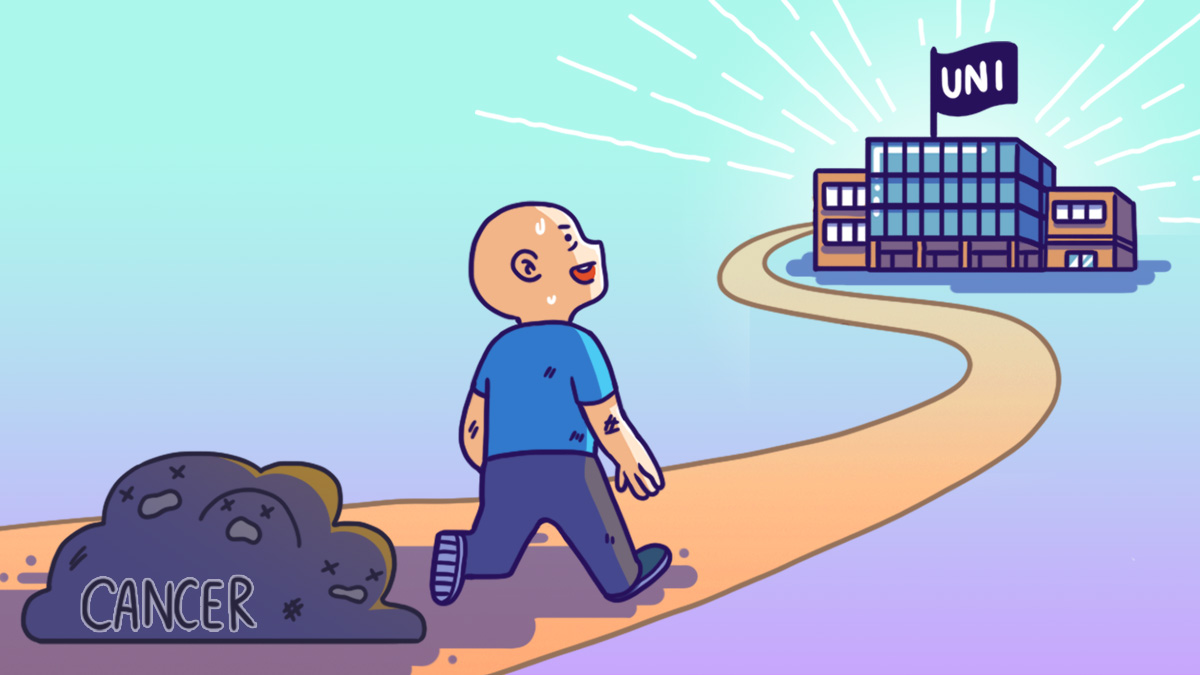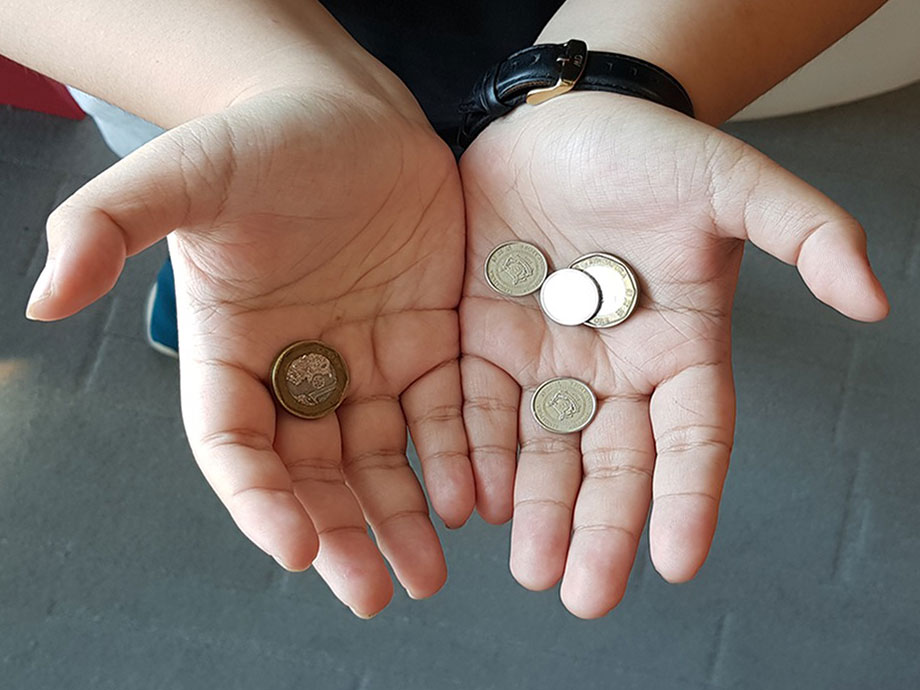Life | Personal Stories | Article
How He Dealt With Stage IV Cancer at Age 21
by Sophia | 3 Feb 2021 | 10 mins read

This article is sponsored by FWD Singapore
John (not his real name) was looking forward to starting his life post-army when life dealt him a difficult card – he was diagnosed with Stage IV cancer at 21. And just like that, John’s life was turned upside down. Right at the cusp of adulthood, he had to grapple with the immense change to his health and lifestyle that his diagnosis brought.
25 years after surviving his cancer, John reflects back on his experience and shares his story with us to help raise awareness and bring comfort to those going through an experience similar to his all those years ago.
This is John’s story.
The Road to Diagnosis
Just six months before finishing his National Service, John noticed swollen lymph nodes on his chest and around his groin area. As he didn’t know much about the lymphatic system, he consulted his army medical officer who then recommended that John do a biopsy of the swollen lymph nodes.
When he got his results back, they “didn’t reveal anything unusual”. The lymph nodes were deemed benign, according to John.
But John began to experience other physical symptoms that were hard to ignore. “My life took a turn when I developed a persistent fever, followed by chills,” he said. “I thought they were caused by the biopsy surgery wound that did not heal well.”
Soon, he was admitted to a hospital where doctors ran a series of tests on John to determine what was going on. The ordeal went on a lot longer than it should have; John was in and out of different hospitals as doctors kept coming back to him with inconclusive results.
Finally, John was diagnosed with Stage IV (late-stage) T-Cell Lymphoma.
“I was not prepared for this,” he reflected. “I was very ill and felt like death. But at the same time, I was relieved I’d finally gotten a diagnosis.”
When Life Takes a Sharp Turn
After his diagnosis, John’s life drastically changed.
“I was looking forward to university,” he said. But instead, John rang in his 21st birthday in the hospital, something he regarded as a particularly cruel twist of fate. In the beginning, he felt a lot of despair and helplessness. After all, he was at the prime of his life at 21 – and the last thing John envisioned was that he would be battling cancer and undergoing chemotherapy at that age.
In the six months following his diagnosis, John underwent six cycles of chemotherapy to bring down his fever and chills, and to stabilise his condition.
“Fortunately, the chemotherapy did bring the cancer cells under control, and my body responded well to it,” he said. “However, it also brought along with it its own set of challenges and inconveniences.”
“The physical pain and fear were unbearable and unforgiving at times,” he said, as he reflected on being poked and prodded with countless needles as part of his treatment.
“It came to a point where my doctors and nurses couldn’t find ‘usable’ veins any longer, either to draw blood from or plant a catheter in. They ended up placing one in my chest.”
He also had to deal with a slew of side effects from his chemotherapy and radiation therapy: hair loss, nausea, physical weakness, and his immune system was severely weakened.
As his immunity was compromised by the chemotherapy and radiation therapy, John was confined at home for a year and not many people could visit him. He needed an environment that was constantly clean and hygienic to minimise his exposure to bacteria and viruses. Not to mention, his environment also had to be safe to prevent even the smallest of injuries that could cause infections.
Though his life took a 180-turn, John always had his family to lean on.
At home, his family supported him and gave him comfort wherever they could – including cooking his favourite dishes for every meal. To pass the time, John would spend his days watching Cantonese dramas and blockbuster movies.
“I was fortunate; Dad’s working hours were flexible, and Mum had many leave days to take so she could accompany me to consultations and treatment sessions,” he said, thankful that his parents did not have to fret or struggle over their finances while taking care of him.
John felt grateful for the support he’d received from friends and extended family, without which he feels that he wouldn’t have made it through this tough time.
The Last Lap of Treatment
Following chemotherapy, the plan was to undergo a round of high-dose radiation therapy to wipe out the cancer cells so that he could then go for an autologous bone marrow transplant.
“My condition improved considerably as chemotherapy helped to keep it under control,” John said. “That allowed me to progress to the next stage of treatment: the autologous bone marrow transplant.”
Unlike a regular transplant that requires an external donor, an autologous bone marrow transplant doesn’t require a donor. Instead, John could rely on his bone marrow for recovery.
With an autologous bone marrow transplant, John could circumvent a gruelling waiting period. “It meant less complications and a lower risk of rejection in the transplant itself,” he added.
But what would have happened if the bone marrow transplant wasn’t successfully? John himself wasn’t sure at the time. “Maybe my parents knew but kept me in the dark about it, but I think that if it didn’t turn out to be a success, we’d have to look for a suitable donor,” he said. “And that would have complicated things and increased the overall risk.”
The radiation therapy would also put John through more suffering; the treatment would weaken his immune system again.
“That was the main risk in all of this, because I’d be put at great risk of infections.”
“Even a simple cold or a cough could kill me,” he said. “So it was a dilemma for me. I was already feeling well, but I knew the transplant process would make me unwell again and even put me at a high risk of death.”
He cycled through fear and confusion during this time. But he wanted regain his life and health. He wanted to win this battle once and for all. So, in the end, he decided to go through with the last lap of his fight against cancer.

As the transplant process began, he was placed in confinement once again to minimise his exposure to viruses or bacteria. Fortunately for John, that was the last time he went into confinement. His transplant was a huge success, despite the risks involved.
“My bone marrow responded well to treatment, and there was an opportunity for it to ‘start anew’ and produce healthy blood cells again.”
The Cost of Recovery
At the time of his initial cancer diagnosis, John just got out of the army and he was surviving on the meagre income he received from NS. Needless to say, he wasn’t prepared to bear the staggering costs of his treatment and recovery.
“The costs of hospitalisation, chemo, medication, and follow-up consultations were hefty and substantial,” he said. “If memory serves me well, everything amounted to around $160K to $180K.”
Chemotherapy treatment is generally expensive in Singapore, ranging from $1,000 to $3,000 according to MOH (though this amount also depends on the hospital ward type you occupy, and whether it’s a public or private hospital), or even up to tens of thousands of dollars. Of course, the cost for chemotherapy will also depend on the type of cancer one is battling.
Other costs involved include the cost of biopsies and tumour removal procedures, which can go up to thousands of dollars.
Thankfully, John had some financial support. His parents covered some of his treatment costs, and he received a payout from his critical illness policy – which he bought at his parents’ recommendation prior to this life-altering event. In addition, his civil service medical coverage from NS also helped to defray the cost of treatment.
Despite the financial support from his parents and his insurance policies, his total medical bill from diagnosis to treatment to recovery was still overwhelming.
“At the age of 21, I had no choice but to depend on my parents for financial support,” he reflected. “Even I had some savings of my own. But my savings weren’t enough. It all gave me perspective about financial management for sure – like putting aside a portion of my income for rainy days as well as to be covered adequately through insurance.”
He stressed the importance of having a critical illness insurance plan at the ready, and for people to start as young as possible the moment they can afford additional coverage.
Overcoming the Odds At Last
25 years on, John looks back on his experience with gratitude.
He attributes his survival to the unconditional love and support he’d received from his friends and family. He also counts himself blessed to have had a dedicated team of doctors and nurses who have helped him along the way in his recovery. John also feels grateful that his parents were able to help him financially through his ordeal.
After a successful transplant, life resumed its regularity. A year later, John went to university in Singapore.
John followed up with his doctor for seven years through regular check-ups before finally being given a positive long-term prognosis.
John even embarked on a three-month vacation in London on his own after the prognosis. “It was a good change of environment for me, and also for my parents – so they could take a break from the burden and stress of looking after me.”

Today, John lives “just like everyone else”. He cites the positive things that have come out of this entire experience with cancer: having his perspective on life changed, becoming more appreciative of the people around him, and even being thankful for the simple, daily tasks that he can do.
“Anyone who goes through this will grow up a lot quicker,” he said, “and will be grateful for another day, taking nothing for granted.”
“Life is certainly back to normal,” he remarked, “even though the rigorous chemotherapy and radiation treatments might have caused lasting effects on me and brought about other medical issues in my present life.
“In spite of all of this, I’m just very thankful I’m alive today.”
Content sponsored by FWD Singapore
About our sponsor: FWD looks to make critical illness protection simple and affordable for everyone. FWD Big 3 Critical Illness insurance provides coverage for cancer, heart attack, and stroke from S$18 a month, with a 100% payout upon a claim to support your recovery. Learn more here.
FWD Big 3 Critical Illness insurance is protected up to specified limit under the Policy Owners’ Protection Scheme which is administered by the Singapore Deposit Insurance Corporation (SDIC). This sponsored story has not been reviewed by the Monetary Authority of Singapore.
The information is meant purely for informational purposes and should not be relied upon as financial advice. You should seek advice from a licensed representative for customised advice on your financial needs.
Buying a life insurance policy is a long-term commitment. You should consider if this policy is suitable for your needs, or you may wish to seek advice from a qualified financial adviser before making a commitment to purchase this policy. Switching from an existing policy to a new one may have potential disadvantages.














